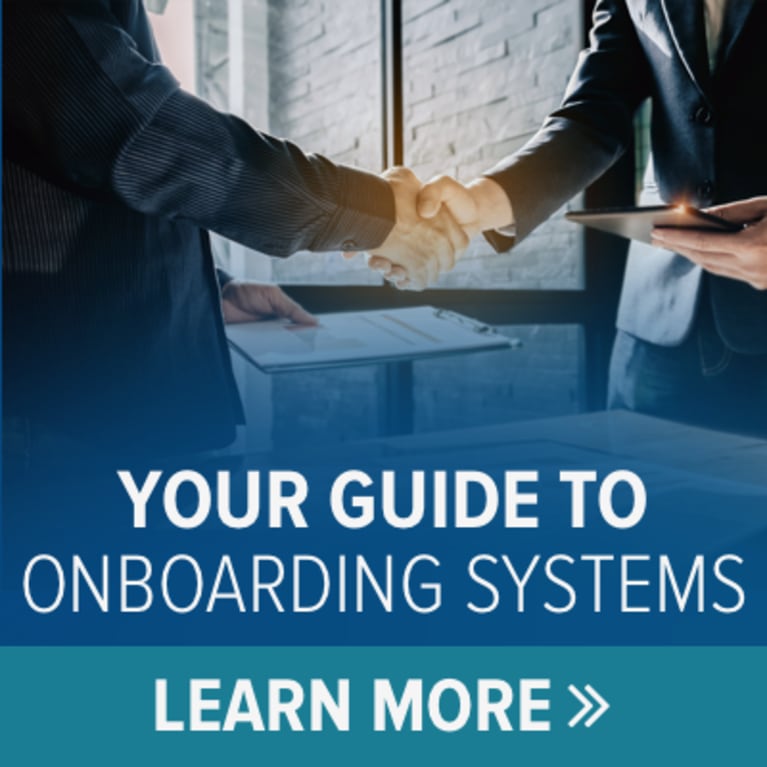 It's no secret that good onboarding practices can reduce turnover and greatly improve new hires' time to proficiency. What many HR leaders may not be aware of, however, is how next-generation onboarding technologies can eliminate much of the manual work in the process, reduce the chance of problems or delays, and leave more time for HR and line managers to train and socialize new employees.
It's no secret that good onboarding practices can reduce turnover and greatly improve new hires' time to proficiency. What many HR leaders may not be aware of, however, is how next-generation onboarding technologies can eliminate much of the manual work in the process, reduce the chance of problems or delays, and leave more time for HR and line managers to train and socialize new employees.
Today's platforms allow new workers, using customized portals, to complete essential digital forms, learn about teammates and begin developing short-term goals even before their first day on the job. Many also feature artificial intelligence (AI)-driven virtual agents to answer commonly asked questions. These portals can customize workflows to match an organization's orientation needs and can send automated reminders to ensure the wide array of onboarding tasks are completed on time.
The stakes are high for choosing the right onboarding system. According to a recent study from research and advisory firm Gartner, nearly one-third of new hires grow dissatisfied and look for a new job within their first six months of employment, and those who stay take an average of eight months to reach acceptable levels of productivity. A recent Gallup study found only 12 percent of employees strongly agree that their organizations do a great job of onboarding new hires.
[SHRM members-only online discussion platform: SHRM Connect]
Choosing an Onboarding Vendor
There are a number of stand-alone or "point" onboarding systems and many that are part of all-inclusive HR software suites. Point systems typically provide the most modern features and functionality, since the vendor is focused only on developing and refining one technology. Stand-alone platforms also can provide more customization options.
Systems that are part of all-in-one HR suites have the advantage of integrating easily with other platforms in the vendor's suite, such as recruiting, learning or core HR systems. This option is appealing to some HR leaders because it means they won't have to shop for an additional system or ask users to learn a different technology interface.
Balancing High-Tech and High-Touch
The many transactional components of onboarding are a good fit for automation and AI, said Jeremy Ames, founder and CEO of Hive Tech HR, a human resources technology consultancy in Medway, Mass. "The onboarding systems that have baked AI into their platforms are trying to save HR and line managers time by moving routine but essential tasks over to self-service tools that can walk new employees through procedures," Ames said.
"These systems are smart enough to know who you are, the key requirements of the job you're starting, the language you speak, potential mentors in your location and more," said Marc Solow, leader of the HR shared services practice at Deloitte Consulting in Atlanta. "They're built to handle a high volume of questions that are asked repeatedly, such as where to park, how to set up direct payroll deposit, how to fill out certain forms and more. The best efficiently hand you off to a human if there's a need to answer more complex questions."
Those automation features can give busy line managers more time to welcome new hires, said Jen Stroud, HR transformation leader at ServiceNow, a Santa Clara, Calif.-based company that provides an onboarding platform.
"If you can use automation to take care of much of the administrative work, it frees you to focus on creating people connections and relationships that strengthen the bonds for new hires and improves retention," Stroud said.
One common challenge of onboarding is that it requires the support of departments beyond HR, like IT, legal, facilities and finance, and interaction among those groups has traditionally relied on manual processes. Many of today's onboarding platforms can bring new efficiency and visibility to those processes by using the automated features of centralized service delivery platforms.
For example, a hiring manager or new hire could access the platform to select the computer equipment needed, kicking off a workflow that tracks how IT is meeting the need. Managers might also select an office space using an interactive floor map, triggering facilities to jump into action. The use of automated reminders helps all parties meet deadlines and creates added accountability.
Sari Wilde, managing vice president in the HR practice at Gartner, said these platforms give line managers much-needed support. According to the Gartner study, managers spend more than twice as much time as HR on onboarding employees.
"There hasn't historically been a great deal of support for line managers responsible for day-to-day onboarding tasks within organizations," Wilde said.
Onboarding Pitfalls and Trends
For successful onboarding there must be uninterrupted communication with new hires in the period between when they accept a job offer and their first day on the job, experts said. Solow knows of one high-tech company that has lost top talent in part because it failed to maintain communication and support in that crucial time.
"The company didn't have a well-defined mechanism to communicate and interact with new hires in that period," Solow said. "As a result, they lost top people to nearby competitors who would swoop in and court these candidates, making them think twice about the offer they'd just accepted."
Wilde reminded HR not to overlook the importance of onboarding existing employees who are transferred or promoted into new roles in the company. How quickly they get up to speed—and how long they stay in their new role—depends in large part on how they're oriented to their job, she said.
"We haven't seen this process owned as much by HR, and it's often not formalized," Wilde said. "Having HR play a bigger role is important, even if it's just in providing onboarding templates and guidelines for line leaders to use."
One notable trend Wilde is seeing is a rise in "employee-owned" onboarding strategies. In these approaches, employees who've recently joined the company play a significant role in onboarding new hires.
"Organizations are realizing these individuals have the greatest understanding of what new hires need, since they've recently gone through the process themselves," Wilde said. "New hires also can feel more comfortable talking to and learning from someone like themselves."
Dave Zielinski is a freelance business writer and editor in Minneapolis.
An organization run by AI is not a futuristic concept. Such technology is already a part of many workplaces and will continue to shape the labor market and HR. Here's how employers and employees can successfully manage generative AI and other AI-powered systems.




